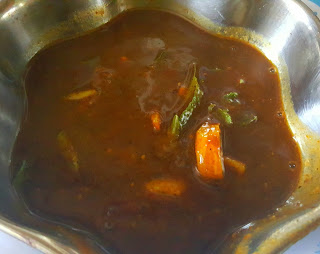Ingredients
Wheat : 2 cups (approx 450gms)
Sugar: 7 cups
Water: 12 cups
Cardomom powder: 1/2 tsp
Ghee: 3 cups
Procedure:
Soak the wheat in sufficient amount of water for 8 hrs. Grind the wheat with some water and extract the wheat milk. To get the milk, grind the wheat in mixie/blender for 5 minutes and filter out the milk. Grind the wheat with fresh water again and filter.Repeat this atleast 3 times. Allow the milk to ferment overnight.
In the morning , you will find that the thick milk has settled at the bottom and the clear liquid on top.Discard the clear liquid. I got approximately 3.5 cups of milk
In a wide non stick pan, pour this milk and add 12 cups of water and mix well. Cook in a medium flame and keep stirring once 3 -5 minutes.After 1 hour, the mixture starts to thicken. At this point add sugar and keep on stirring
Once it reaches semi solid stage, add ghee little by little and keep on stirring.After another 1 hour or so, the ghee will start oozing out.The halwa will look transparent as well.When you take the mixture in the laddle, it should slide and not stick to the laddle.
The ghee will really start oozing out at the last stage. I recollected more than 1/4 cup of ghee. once I was done with the Halwa. Add cardomom powder and fried cashews and switch off the flame. Decorate with cashews, almonds & pistachios for rich taste.
For getting exact colour of the halwa
Heat 3 tsp of ghee. Add 2 tsp of sugar and keep stirring until the sugar starts melting and starts caramelizing. At one point (within a minute or two), the ghee starts changing color to brown.Pour this to the Halwa mixture and you will get the required color naturally.














